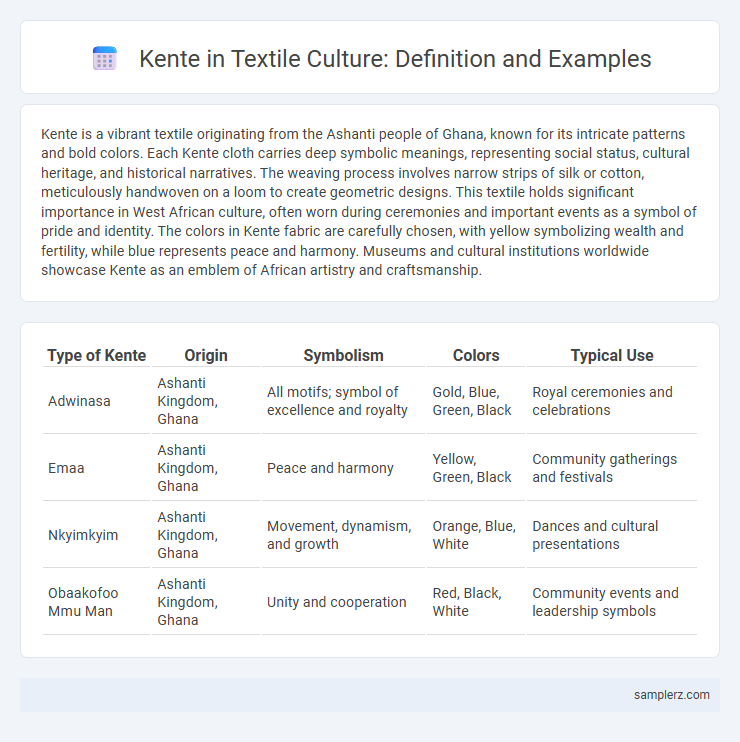Kente is a vibrant textile originating from the Ashanti people of Ghana, known for its intricate patterns and bold colors. Each Kente cloth carries deep symbolic meanings, representing social status, cultural heritage, and historical narratives. The weaving process involves narrow strips of silk or cotton, meticulously handwoven on a loom to create geometric designs. This textile holds significant importance in West African culture, often worn during ceremonies and important events as a symbol of pride and identity. The colors in Kente fabric are carefully chosen, with yellow symbolizing wealth and fertility, while blue represents peace and harmony. Museums and cultural institutions worldwide showcase Kente as an emblem of African artistry and craftsmanship.
Table of Comparison
| Type of Kente | Origin | Symbolism | Colors | Typical Use |
|---|---|---|---|---|
| Adwinasa | Ashanti Kingdom, Ghana | All motifs; symbol of excellence and royalty | Gold, Blue, Green, Black | Royal ceremonies and celebrations |
| Emaa | Ashanti Kingdom, Ghana | Peace and harmony | Yellow, Green, Black | Community gatherings and festivals |
| Nkyimkyim | Ashanti Kingdom, Ghana | Movement, dynamism, and growth | Orange, Blue, White | Dances and cultural presentations |
| Obaakofoo Mmu Man | Ashanti Kingdom, Ghana | Unity and cooperation | Red, Black, White | Community events and leadership symbols |
Origins and Cultural Significance of Kente in Textile Arts
Kente cloth originated among the Ashanti people of Ghana, symbolizing royal authority and cultural heritage through its intricate patterns and vibrant colors. This textile art technique involves weaving silk and cotton threads into distinct geometric designs, each pattern conveying specific proverbs, historical events, or social values. Kente serves not only as a garment but also as a powerful emblem of identity, status, and storytelling within West African culture.
Traditional Patterns and Their Meanings in Kente Cloth
Kente cloth, originating from the Ashanti people of Ghana, features intricate traditional patterns each symbolizing distinct cultural values such as unity, spirituality, and leadership. Common motifs like "Eban" represent safety and security, while "Adinkrahene" signifies authority and charisma. These patterns are woven using vibrant colors that also convey specific meanings, making Kente a rich tapestry of African heritage and storytelling.
Materials and Techniques Used in Kente Weaving
Kente weaving employs hand-woven silk and cotton threads, utilizing the traditional strip weaving technique on a horizontal loom to create vibrant, intricate patterns. Skilled artisans interlace brightly colored yarns, often dyed with natural substances like indigo and kola nuts, to form geometric motifs symbolizing cultural values and social status. The meticulous process combines both warp and weft threads to produce durable, lightweight cloth favored in ceremonial attire across West African societies.
Symbolism in Kente Colors and Designs
Kente cloth, a traditional Ghanaian textile, uses vibrant colors and intricate patterns that hold deep symbolic meaning; for instance, gold represents wealth and royalty, while green signifies growth and renewal. Each design in Kente reflects specific proverbs, historical events, or ethical values, making the fabric a visual language of cultural identity. The deliberate combination of colors and motifs conveys messages of social status, spirituality, and community heritage.
Regional Variations of Kente Textiles Across Ghana
Kente textiles showcase distinct regional variations across Ghana, with the Ashanti region known for its bold, geometric patterns in bright yellows and blacks symbolizing royalty and spiritual values. In contrast, the Ewe kente from the Volta region features narrow stripes and intricate motifs that often represent proverbs and historical narratives. These regional differences reflect diverse cultural identities and social meanings embedded in the weaving techniques and color symbolism.
Kente in Modern Fashion and Contemporary Design
Kente cloth, traditionally woven by the Ashanti people of Ghana, has become a symbol of African heritage in modern fashion, celebrated for its vibrant patterns and bold colors. Designers incorporate Kente into contemporary apparel, blending its historical significance with innovative silhouettes to create garments that honor cultural identity while appealing to global fashion markets. This fusion of traditional textile craftsmanship and modern design techniques elevates Kente beyond ceremonial use, positioning it prominently in runway shows, streetwear, and high-end fashion collections worldwide.
Ceremonial and Everyday Uses of Kente Fabric
Kente fabric, originating from the Ashanti people of Ghana, holds deep cultural significance both in ceremonial and everyday contexts. Traditionally worn during important ceremonies such as weddings, funerals, and festivals, kente symbolizes identity, status, and heritage through its vibrant patterns and colors. In everyday life, lighter kente fabrics are used in clothing and accessories, reflecting cultural pride while blending functionality with aesthetic appeal.
Influence of Kente Textile on Global Art and Culture
Kente textile, originating from the Ashanti people of Ghana, has profoundly influenced global art and culture through its vibrant patterns and symbolic meanings. Its unique weaving techniques and bold color schemes have inspired contemporary fashion designers and artists worldwide, integrating traditional African aesthetics into modern creative expressions. Museums and cultural institutions globally showcase Kente as a symbol of African heritage, promoting cross-cultural appreciation and fostering a greater understanding of African identity.
Preserving Kente Weaving: Challenges and Innovations
Kente weaving, a traditional Ghanaian textile art, faces challenges such as dwindling numbers of skilled artisans and the pressure of mass-produced imitations undermining its authenticity. Innovative efforts include digital archiving of weaving patterns and community-led workshops that teach younger generations the intricate craftsmanship. Preserving kente weaving ensures the cultural heritage and symbolic meanings embedded in its vibrant, geometric patterns continue to thrive.
Authenticity and Ethical Sourcing in Kente Production
Kente cloth, traditionally handwoven by the Ashanti and Ewe people of Ghana, exemplifies authentic cultural heritage through its intricate patterns and symbolism. Ethical sourcing in Kente production involves supporting local artisans who use natural dyes and sustainable materials, preserving both the environment and ancestral craftsmanship. Ensuring authenticity means verifying that Kente textiles are produced within Ghana under fair trade practices, which protects the cultural significance and economic livelihood of the weavers.

example of kente in textile Infographic
 samplerz.com
samplerz.com